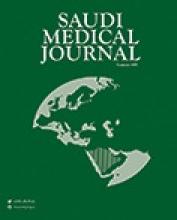Abstract
OBJECTIVE: To compare the effectiveness of misoprostol (600 ug) when administered sublingually with the same dose administered per rectum to patients, immediately after delivery in preventing postpartum hemorrhage (PPH).
METHODS: This study was carried out in Al Thawra General Hospital, Sana'a, Yemen, from May 1, 2007 to April 31, 2008. A total of 215 women were recruited, and divided into 2 groups in a quasi-random fashion. Group I comprised 118 women, and was given 600 ug misoprostol sublingually immediately after delivery. The other group comprised 97 women (group II), and was given the same dose of misoprostol per rectum. The blood loss was measured, and the side effects of the misoprostol were assessed. The need for additional uterotonic agents, blood transfusion, and the length of the third stage labor were recorded.
RESULTS: Nine patients in group I, and 7 patients in group II had PPH. Of these patients, blood loss was >1000 ml in 4 patients in group I, but <1500 ml in 3 patients in group II, (relative risk - 1.05, 0.40 - 2.73 confidence interval [95%]. The mean blood loss was 362.3 ± 170 ml in group I versus 342.3 ± 154.7 ml in group II. Only 3 cases (3%) of the patients in group I were given additional uterotonic agents versus 2 cases (2%) in group II.
CONCLUSION: Postpartum use of 600 ug misoprostol by sublingual route has a comparable effect in reducing PPH, as that of rectal route. It was observed that severe PPH (1000 ml but <1500 ml) had been observed in 40% of those who developed PPH in both groups.
- Copyright: © Saudi Medical Journal
This is an open-access article distributed under the terms of the Creative Commons Attribution-Noncommercial-Share Alike 3.0 Unported, which permits unrestricted use, distribution, and reproduction in any medium, provided the original work is properly cited.






